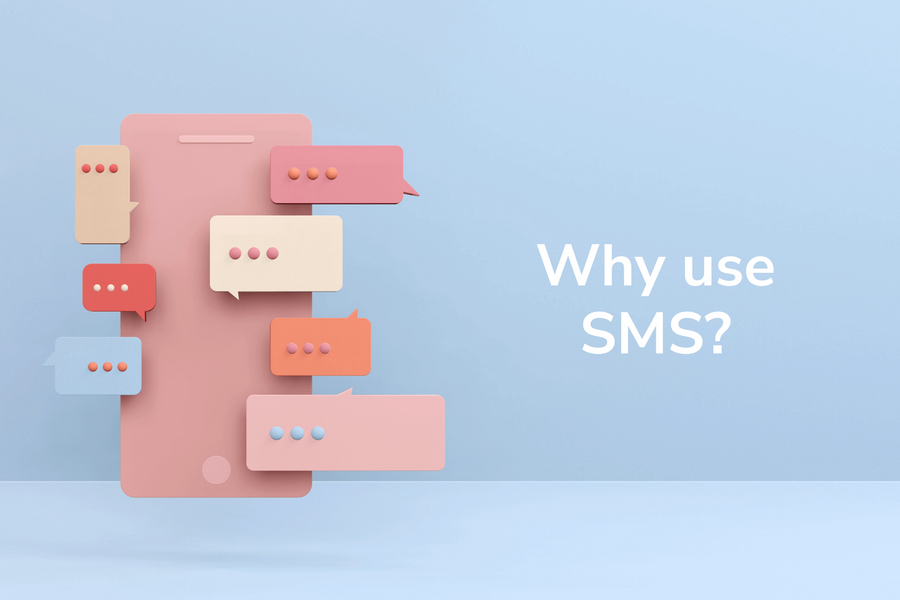The Rise of Text Message Marketing
Phones are practically a consumer lifeline, used from homes and busses, from sports arenas, concerts, and even from mountaintops.
In recent years, marketers have embraced SMS as part of a mobile-first marketing approach to meet consumers in all of these places. Once underutilized, SMS marketing is now on the rise as businesses understand the value of connecting with consumers wherever they may be.
Widespread adoption of SMS across diverse industries means that many consumers now expect text notifications from businesses. Whether that’s a text notification from your Uber driver, a timely appointment reminder from your doctor’s office, or real-time text message updates for order deliveries.
If you’re wondering why SMS should be part of your marketing strategy, here’s a high-level breakdown of what this channel can offer that other channels can’t.
6 Reasons Why SMS is a Powerful Communication Channel
1. It’s Stimulating
With a ding and a buzz, an SMS pops into view, lighting up a user’s phone screen — and their brain’s reward system. The arrival of a text message stimulates the dopamine system, the part of the brain that creates feelings of desire. Anticipating and receiving texts reinforces this reward cycle, which keeps users glued to their messages.
Knowing the attachment consumers have to their phones, it’s only logical that companies are turning to SMS as a key piece of their multichannel marketing strategies to reach users where they’re already reliably (and biologically) engaged.
2. It’s Direct and Immediate
SMS reaches consumers on their native text apps. These messages arrive instantly and are viewed quickly. In fact, 90 percent of text messages are read within 3 minutes of being received. This has powerful implications for the speed and reach of your messages.
In addition, consumers can receive text messages without downloading your app or visiting your website, which differentiates this channel from web, mobile, and in-app messaging channels. Because individuals who haven’t downloaded your app can still engage with your brand through SMS, you can reach new audiences, including consumers who don’t have a smartphone or an internet connection. While smartphone penetration is high in countries like the U.S., recent data shows that on a global scale, 1.1 billion people still use a mobile phone that’s not a smartphone. If you’re interested in engaging global audiences, SMS is a wise choice.
3. It’s Engaging
When it comes to user engagement rates, other channels pale in comparison to SMS. While the average email campaign yields an open rate of 20 percent, SMS open rates are as high as 98 percent. When it comes to getting eyes on your messages quickly, SMS is a compelling choice.
Text messages also have a shorter response time than other channels. Whereas emails have an average response time of 90 minutes, text message response times average just 90 seconds. In addition, up to 45 percent of consumers respond to SMS while only 6 percent respond to email. There’s the dopamine loop in action!
4. It’s Preferred
Consumers may also be more receptive to SMS marketing messages than they are to offers shared through other channels.
In one study, 75 percent of consumers said they’d prefer receiving offers through SMS, and 57 percent said they’d be happy to participate in an SMS loyalty program. Consumers inundated with digital marketing messages might prefer SMS marketing if given the choice to receive offers via SMS as opposed to other oversaturated channels.
Consumers want to start a text conversation with your business, which is something you should take advantage of.
5. It’s Versatile Across Verticals
Businesses across diverse industries are turning to SMS to acquire, engage, and retain customers. SMS marketing is touted in the financial services, food delivery, e-commerce, retail, and nonprofit sectors.
Retail companies send their SMS lists coupons and limited-time offers. The Red Cross has raised millions of dollars in donations through an SMS campaign. Pharmacies, banks, and doctors’ offices send appointment reminders and time-sensitive updates to their clients. In short, SMS can support a variety of transactional and marketing use cases.
The versatility of SMS offers potential for many types of businesses—whether you’re a large tech enterprise, a small dog grooming business, a cupcake delivery service, or a medical or financial services provider— to slide in and connect with customers.
6. It’s Multipurpose
Used strategically, SMS has a place in every phase of the buyer's journey, from nurture to purchase. Marketers are turning to SMS to inform their audiences, grow customer relationships, and promote sales for their businesses.
SMS can be used for both transactional and promotional messages.
Promotional SMS encompass all sales and marketing messages, which promote your brand and the products or services you offer. Examples include discounts, limited time offers, new merchandise alerts, etc. Transactional messages, in contrast, transmit logistical information such as passwords, payment updates, order status, appointment reminders, or delivery updates. Transactional messages provide helpful and timely information to users, while promotional messages serve your brand.
Learn More About SMS Marketing Strategy
Want to start using SMS but not sure where to begin? Check out our SMS eBook to learn fundamental SMS messaging strategies, use cases, best practices, and tips for leveraging SMS across industries. Get The Comprehensive Guide to SMS Marketing.
Get Started with OneSignal
OneSignal is designed to help you send notifications and seamlessly manage your user communication across every channel, including bulk SMS, email, mobile push notifications, web push notifications, and in-app messaging. Our platform is quick to set up and makes it easy to automate your text messaging campaigns without doing any development work. If you don't have a OneSignal account, you can create one for free — sign up and see for yourself!
Get Started for Free



